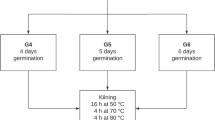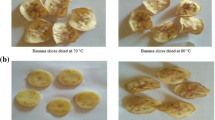Abstract
The growth of Bacillus cereus on blanched spinach with or without seasoning at various temperatures (15, 20, 25, 30, and 35°C) was investigated. The number of B. cereus on blanched spinach stored at 35°C was significantly increased and resulted in maximum populations (7.8 log CFU/g) after 10 h. However, the growth rate of B. cereus on blanched spinach with seasoning stored at 35oC was lower than on blanched spinach without seasoning. The growth rate (GR) of B. cereus on blanched spinach stored at 15°C was lower than the other temperatures. The lag time (LT) of B. cereus on blanched spinach with seasoning was longer than blanched spinach without seasoning. Primary growth models of B. cereus on blanched spinach fit well to a modified Gompertz model (blanched spinach R2 =0.98; blanched spinach with seasoning R2 =0.96). These results might be used for developing safe storage guidelines for cooked vegetable at various temperatures.
Similar content being viewed by others
References
Tornuk F, Cankurt H, Ozturk I, Sagdic O, Bayram O, Yetim H. Efficacy of various plant hydrosols as natural food sanitizers in reducing Escherichia coli O157:H7 and Salmonella Typhimurium on fresh cut carrots and apples. Int. J. Food Microbiol. 148: 30–35 (2011)
Tournas VH. Moulds and yeasts in fresh and minimally processed vegetables and sprouts. Int. J. Food Microbiol. 99: 71–77 (2005)
Adrienne E, Shearer H, Christine MS, Rolf DJ. Evaluation of a polymerase chain reaction-based system for detection of Salmonella enteritidis, Escherichia coli O157:H7, Listeria spp., and Listeria monocytogenes on fresh fruits and vegetables. J. Food Protect. 64: 788–795 (2001)
Lee SY, Yun KM, Fellman J, Kang DH. Inhibition of Salmonella Typhimurium and Listeria monocytogenes in mungbean sprouts by chemical treatment. J. Food Protect. 65: 1088–1092 (2002)
Lee SY, Baek SY. Effect of chemical sanitizer combined with modified atmosphere packaging on inhibiting Escherichia coli O157:H7 in commercial spinach. Food Microbiol. 25: 582–587 (2008)
Sewell AM, Farber JM. Foodborne outbreaks in Canada linked to produce. J. Food Protect. 64: 1863–1877 (2001)
Carlin F, Girardin H, Peck MW, Stringer SC, Barker GC, Martinez A, Fernandez A, Waites WM, Movahedi S, van Leusden F, Nauta M, Moezelaar R, del Torre M, Litman S. Research on factors allowing a risk assessment of spore-forming pathogenic bacteria in cooked chilled foods containing vegetables: A FAIR collaborative project. Int. J. Food Microbiol. 60: 117–135 (2000)
Choma C, Guinebretière MH, Carlin F, Schmitt P, Velge P, Granum P., Nguyen-The C. Prevalence, characterization, and growth of Bacillus cereus in commercial cooked chilled foods containing vegetables. J. Appl. Microbiol. 88: 617–625 (2000)
Peck MW. Clostridium botulinum and the safety of refrigerated processed foods of extended durability. Trends Food Sci. Tech. 8: 186–192 (1997)
Malakar PK, Barker GC, Peck MW. Modeling the prevalence of Bacillus cereus spores during the production of a cooked chilled vegetable product. J. Food Protect. 67: 939–946 (2004)
Heo SK, Lee JY, Baek SB, Ha SD. A response surface model to describe the effect of temperature and pH on the growth of Bacillus cereus in cooked rice. J. Food Protect. 72: 1296–1300 (2009)
Jaquette CB, Beuchat LR. Survival and growth of psychrotrophic Bacillus cereus in dry and reconstituted infant rice cereal. J. Food Protect. 61: 1629–1635 (1998)
Nichols GL, Little CL, Mithani V, de Louvois J. The microbiological quality of cooked rice from restaurants and takeaway premises in the United Kingdom. J. Food Protect. 62: 877–882 (1999)
Tessi MA, Aringoli EE, Pirovani ME, Vincenzini AZ, Sabbag NG, Costa SC, Garcia CC, Zannier MS, Silva ER, Moguilevsky MA. Microbiological quality and safety of ready-to-eat cooked foods from a centralized school kitchen in Argentina. J. Food Protect. 65: 636–642 (2002)
Tian D, Shim YH, Kim HN, Ha SD, Chung MS, Hwang IG, Oh DH. Development of predictive model for the growth of Staphylococcus aureus in kimbab. Food Sci. Biotechnol. 20: 471–476 (2011)
Kim BY, Lee JY, Ha SD. Growth characteristics and development of a predictive model for Bacillus cereus in fresh wet noodles with added ethanol and thiamine. J. Food Protect. 74: 658–664 (2011)
Mataragas M, Drosinos EH, Siana P, Skandamis P, Metaxopoulos I. Determination of the growth limits and kinetic behavior of Listeria monocytogenes in a sliced cooked cured meat product: Validation of the predictive growth model under constant and dynamic temperature storage conditions. J. Food Protect. 69: 1312–1321 (2006)
Hwang CA, Sheen S. Growth characteristics of Listeria monocytogenes as affected by a native microflora in cooked ham under refrigerated and temperature abuse conditions. Food Microbiol. 28: 350–355 (2011)
Gibson AM, Bratchell N, Roberts TA. Predicting microbial growth: Growth responses of salmonella in a laboratory medium as affected by pH, sodium chloride, and storage temperature. Int. J. Food Microbiol. 6: 155–178 (1988)
Yang ZQ, Jiao XA, Li P, Pan ZM, Huang JL, Gu RX, Fang WM, Chao GX. Predictive model of Vibrio parahaemolyticus growth and survival on salmon meat as a function of temperature. Food Microbiol. 26: 606–614 (2009)
Carlin F, Peck MW. Growth of and toxin production by nonproteolytic Clostridium botulinum in cooked puréed vegetables at refrigeration temperatures. Appl. Environ. Microb. 62: 3069–3072 (1996)
Valeroa M, Fernández PS, Salmerón MC. Influence of pH and temperature on growth of Bacillus cereus in vegetable substrates. Int. J. Food Microbiol. 82: 71–79 (2003)
Fenwick GR, Hanley AB. The genus Allium. Part III. Crit. Rev. Food Sci. 23: 1–73 (1985)
Yin MM, Tsao SM. Inhibitory effect of 7 Allium plants upon 3 Aspergillus species. Int. J. Food Microbiol. 49: 49–56 (1999)
Lee CF, Han CK, Tsau JL. In vitro inhibitory activity of Chinese leek extract against Campylobacter species. Int. J. Food Microbiol. 94: 169–174 (2004)
Dewitt C, Notermans S, Gorin N, Kampelmacher H. Effect of garlic oil or onion oil on toxin production by Clostridium botulinum in meat slurry. J. Food Protect. 42: 222–224 (1979)
Al-Waili NS, Saloom KY, Akmal M, Al-Waili TN, Al-Waili AN, Al-Waili H, Ali A, Al-Sahlani K. Effects of heating, storage, and ultraviolet exposure on antimicrobial activity of garlic juice. J. Med. Food 10: 208–212 (2007)
Hwang CA, Marmer BS. Growth of Listeria monocytogenes in egg salad and pasta salad formulated with mayonnaise of various pH and stored at refrigerated and abuse temperatures. Food Microbiol. 24: 211–218 (2007)
Jin SS, Jin YG, Yoon KS, Woo GJ, Hwang IG, Bahk GJ, Oh DH. Predictive modeling of the growth and survival of Listeria monocytogenes using a response surface model. Food Sci. Biotechnol. 15: 715–720 (2006)
Ross T. Indices for performance evaluation of predictive models in food microbiology. J. Appl. Bacteriol. 81: 501–508 (1996)
Choi JH, Kim EJ, Yoon KS, Kwak TK. The growth kinetics of S. aureus inoculated onto potentially high risk foods in school foodservice operations. Korean J. Food Cookery Sci. 26: 335–345 (2010)
Membré JM, Kan-King-Yu D, Blackburn CdeW. Use of sensitivity analysis to aid interpretation of a probabilistic Bacillus cereus spore lag time model applied to heat-treated chilled foods (REPFEDs). Int. J. Food Microbiol. 128: 28–33 (2008)
Author information
Authors and Affiliations
Corresponding author
Rights and permissions
About this article
Cite this article
Bae, YM., Kim, BR., Lee, SY. et al. Growth and predictive model of Bacillus cereus on blanched spinach with or without seasoning at various temperatures. Food Sci Biotechnol 21, 503–508 (2012). https://doi.org/10.1007/s10068-012-0064-7
Received:
Revised:
Accepted:
Published:
Issue Date:
DOI: https://doi.org/10.1007/s10068-012-0064-7




